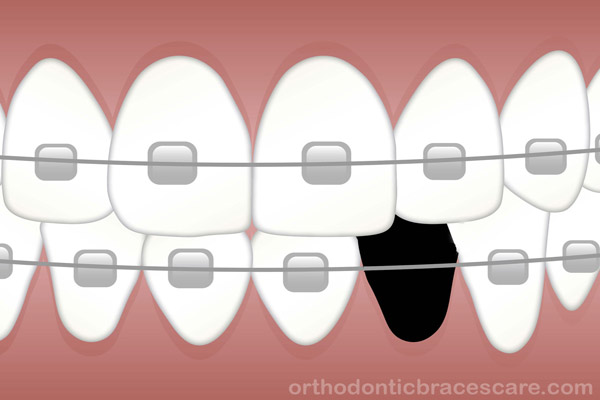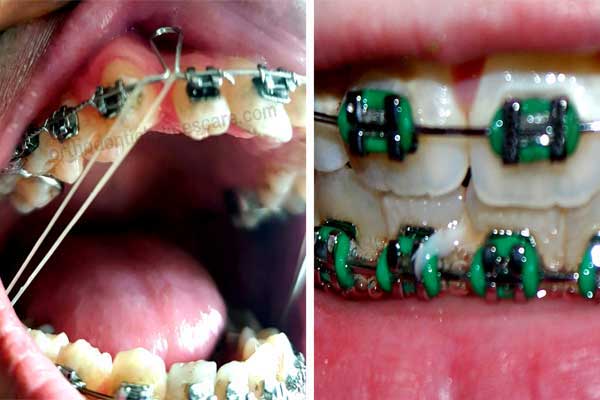After getting braces removed, everyone expects to have straight teeth forever. But, can you have flared teeth after braces?
You can have flared teeth after braces when you don’t wear the retainers regularly or remove braces before completing the treatment. However, you can fix this issue by wearing retainers or, in severe cases, by getting other orthodontic treatments such as braces or Invisalign.
In this article, we will be discussing teeth flaring after braces in detail including the causes and ways how you can fix it.
What are flared teeth after braces?
Flared teeth are a condition where the upper and lower teeth do not touch when the mouth is closed, but rather “flare” out. The front teeth in this situation lean outward rather than downward.
You might have flared teeth even before braces due to bite problems, bad oral habits, overcrowded teeth, or a small jaw.
But, once you get braces and your teeth are moved into the right position, the flared teeth can get corrected.
However, in some cases, you may experience flared or buck teeth after braces if you don’t wear retainers properly after the braces come off.
It can be one of many causes of your teeth looking weird after braces.
Are flared teeth normal after braces?
After having braces removed, it is not uncommon to have flared teeth. In fact, many people who don’t wear their retainers regularly will experience this problem. So, to prevent this you have to wear retainers after the braces come off.
If you don’t wear your retainer as prescribed by the orthodontist, your teeth may start to shift back to their original position. This can result in teeth sticking out again after braces.
What causes flared teeth after braces?
Take a look at the causes of why your teeth flare after braces.
1. Tooth settling
After getting braces removed, it’s normal that your teeth shift slightly because there are no braces to hold them in position. Even with retainers, teeth may move a little and it may seem your teeth are flaring after braces.
However, it can be corrected if you wear the retainers as prescribed.
2. Not wearing the retainers regularly
Wearing retainers is vital after you get braces off. The purpose of a retainer is to keep your teeth from moving back to their original position.
If you don’t wear your retainers regularly as prescribed, your teeth will start to shift out of place and flare out again.
So, if you had an overbite that was corrected with braces, may come back after getting the braces removed.
The same is true if you stop wearing your retainer after your teeth have been moved into the right position.
If you have gapped teeth previously that are fixed by braces, not wearing retainers can also reopen the gaps.
3. Removing braces before the treatment is completed
Another reason can be you might have removed your braces before the treatment was completed.
So, in this case, the teeth may not have had enough time to adjust to the new position and may start to flare out again.
4. Poor-fitting retainer
Another potential reason can be you might have gotten a poor-fitting retainer. This is because it can’t control the tooth movement and causes flared teeth.
It may occur when the retainer is not made according to the specifications of your mouth. The retainer may also become ill-fitted if you don’t wear it regularly.
5. Having bad oral habits
Bad oral habits like chewing on ice, biting your nails, or using your teeth to open things can result in flared teeth.
If your kid has thumb sucking habit, it can also cause protruding teeth after braces.
6. Issue with tongue
Tongue thrusting is a condition where the tongue sticks out between the teeth while swallowing. This can cause the front teeth to flare out.
Other tongue-related issues like having a large tongue or webbed tongue can also result in flared teeth.
7. Not consulting with your orthodontist
If you don’t consult with your orthodontist, they may not be able to detect the early signs of flared teeth.
This can further lead to extensive damage and may require surgery to fix the problem.
8. Poor treatment outcome
If you had a poor treatment outcome, it can also lead to flared teeth.
9. Orthodontic relapse
Orthodontic relapse is another reason for flared teeth. It happens when your teeth start to shift back to their original position after the brackets are removed.
If you had severe malocclusion with skeletal or jaw bone issues, your teeth might be flared out even after months or years after braces.
10. Incorrectly positioned teeth
If your teeth are positioned incorrectly, it can result in flared teeth.
11. Inappropriate treatment planning
If you had a poor treatment plan, it can also lead to flared teeth. Orthodontic treatment may need to remove some teeth to create space to align teeth correctly.
When there is not enough space in your mouth for all your teeth and teeth aren’t removed to create space, you may have flared teeth even after completion of braces treatment.
Moreover, if the crooked teeth were due to severe skeletal problems such as small or big jaw bones, it may also happen.
This is because severe skeletal malocclusion may need surgery to correct occlusion.
However, a good orthodontist will give you the right treatment planning. But, sometimes, it may be a patient who may want to get the bite correction done without tooth extraction or surgery.
This can lead to teeth flaring after the end of orthodontic treatment.
How to fix flared teeth after braces?
Here are some ways to fix teeth flaring after braces.
1. Wear retainers again.
If your teeth are starting to flare after getting braces off, the first thing you should do is start wearing your retainer as prescribed.
If you don’t have a retainer, or if you lost it, you need to get in touch with your orthodontist so they can prescribe a new one.
Keep in mind that your teeth will continue to slant forward after braces if you’re not wearing a retainer as directed.
In some cases, you may need to wear your retainer all the time or get a new type of retainer worn all the time, such as a bonded retainer.
The type of retainers that you’ll get will depend on your individual case.
2. Get Invisalign aligners.
If the retainer isn’t enough to correct the flared teeth after braces, getting Invisalign clear aligners can be a great option. It can help to move your teeth back into place and stop the flaring.
Invisalign is an excellent option because unlike braces they are removable and comfortable. Moreover, it is practically invisible, so no one will even know you’re wearing them.
3. Get back to braces.
If your teeth are severely flared, you may need to get back to braces in order to fix the problem. In some cases, this may be the only way to fix the issue.
4. Have surgery.
In some cases, surgery may be the only way to fix flared or buck teeth. This is usually only recommended in severe cases where other treatments have not worked.
If you’re considering surgery, you should make an appointment with an oral surgeon so they can assess your individual case and recommend the best course of treatment.
Finally, if you’re not sure what to do about your flared teeth, you should make an appointment with your orthodontist so they can assess the situation and recommend the best treatment option for you.
How do you prevent teeth from flaring after braces?
You can prevent flared or protruded teeth after braces by following ways.
1. Wearing a retainer.
The best way to prevent your teeth from flaring following braces treatment is to wear your retainer as instructed by your orthodontist. Depending on your individual case, you may need to wear your retainer all the time, or just at night.
It is also important to practice good oral hygiene habits and visit your dentist regularly.
There are mainly 3 types of retainers that you might need to prevent flared teeth after orthodontic treatment.
Acrylic retainers
These retainers are the most common type. They consist of a metal wire that goes around the outside of your teeth and is held in place by acrylic on the inside of your teeth.
Fixed retainers
These retainers are bonded to the back of your teeth and can only be removed by an orthodontist.
Clear retainers
These retainers are made of clear plastic and are less visible than other types of retainers.
2. Completing the treatment
It is important to complete the treatment as per the orthodontist’s instructions. This will help ensure that your teeth stay in place and don’t start flaring out again.
3. Fitting braces properly
If you are getting braces fitted, make sure that they are correctly fitted. This will help avoid any problems with your teeth flaring out.
4. Staying away from bad oral habits
Avoiding bad oral habits such as chewing on hard objects or biting your nails will help prevent your teeth to slant forward after braces
In addition, if you have a tongue thrusting habit or a large-sized tongue, you need to consult with your orthodontist to solve the issue to prevent teeth flaring.
How long does it take to fix flared teeth after braces are removed?
It typically takes around six to eight weeks for the teeth to settle into their new positions after braces are removed. However, it is not unusual for it to take up to a few months for the teeth to completely adjust. In some cases, slight irregularities may still be present even after the adjustment period.
This is usually nothing to worry about and will not affect the function or appearance of the teeth. If you are concerned about any irregularities, consult your orthodontist for advice.
Do retainers help with flared teeth after braces?
Retainers can help correct flared teeth. By holding the teeth in their new position after braces are removed, retainers can help prevent the teeth from moving back into their original position.
If you are considering using retainers to correct your flared teeth, consult your orthodontist for advice. They will be able to assess your individual case and advise you on the best course of action.
Conclusion
Not wearing a retainer as prescribed by your orthodontist is the main cause of your teeth flaring after braces. Getting braces off early, relapse due to abnormal oral habits, and other causes may be responsible for that.
However, there are ways to fix flared teeth after braces, including wearing a retainer again, getting Invisalign aligners, or in severe cases, getting back to braces.
Pallab Kishore is a certified dentist and the owner of Orthodontic Braces Care.
He completed BDS in 2014. Now, he is an MS resident in Orthodontics, BSMMU. He likes content writing and has 12+ years of experience in blogging.


